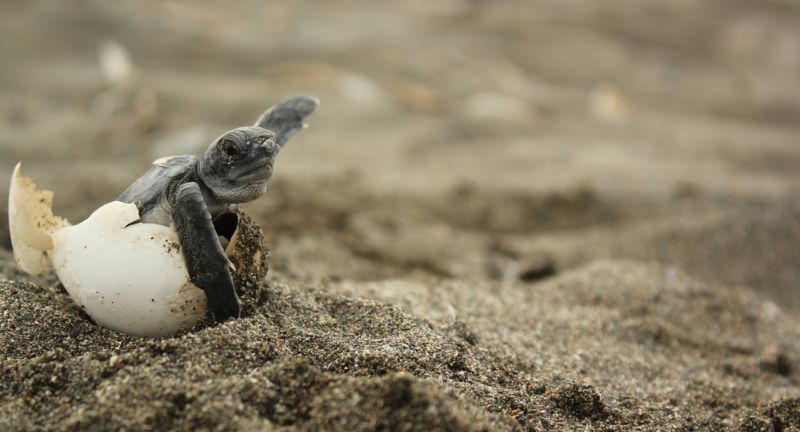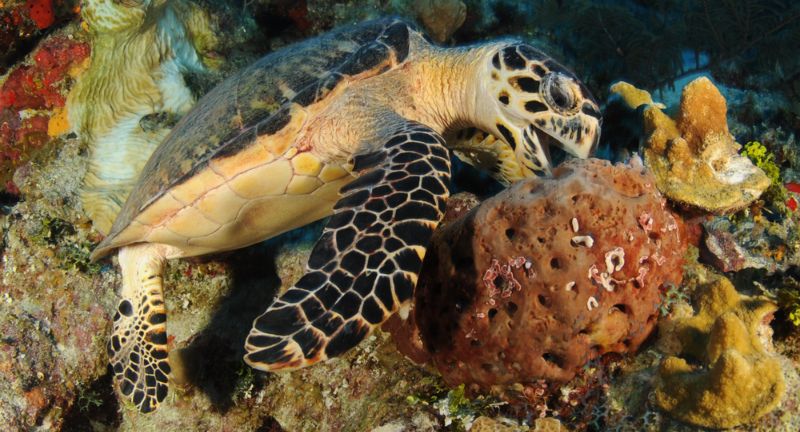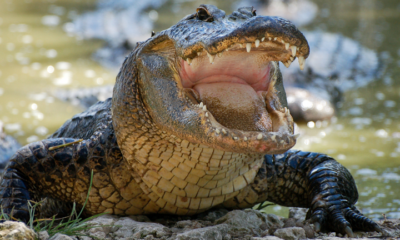REPTILES
25 Reasons Why Sea Turtles Are the Ocean’s Most Fascinating Creatures
Published
6 months agoon

Shutterstock
Sea turtles are among the most fascinating and ancient creatures inhabiting our oceans. With their unique adaptations and incredible resilience, these marine reptiles have captured the imagination of people around the world. However, despite their long history, sea turtles face numerous threats that have led to many species becoming endangered. Understanding these magnificent animals and their role in marine ecosystems is crucial for their conservation. Here, we explore 25 fascinating facts that highlight the wonder and importance of sea turtles.
Ancient Mariners

Shutterstock
Sea turtles have roamed the oceans for over 100 million years, surviving through countless changes in the Earth’s environment. Their existence predates even some of the most well-known species of dinosaurs, making them one of the oldest creatures on the planet. These ancient mariners have witnessed the rise and fall of many species, proving their incredible resilience. Despite their long history, sea turtles are now facing unprecedented threats from human activities.
Seven Species

Shutterstock
There are seven distinct species of sea turtles, each with its own unique characteristics and habitats. These species include the Leatherback, Green, Loggerhead, Hawksbill, Olive Ridley, Kemp’s Ridley, and the Flatback. They can be found in oceans all over the world, from tropical beaches to temperate waters. Despite their differences, all species are integral to the health of marine ecosystems.
Leatherback Giants

Shutterstock
The Leatherback turtle is the largest of all sea turtle species, reaching lengths of up to 7 feet and weights as much as 2,000 pounds. These gentle giants have a unique leathery shell, unlike the hard shells of other sea turtles. Despite their massive size, Leatherbacks are graceful swimmers, capable of diving to depths of over 3,000 feet in search of jellyfish. Their immense size and deep-diving ability make them one of the most remarkable creatures in the ocean.
Migratory Marvels

Shutterstock
Sea turtles are known for their incredible migratory patterns, often traveling thousands of miles between their feeding grounds and nesting beaches. These long journeys are guided by their innate ability to navigate using the Earth’s magnetic fields. Some species, like the Loggerhead, are known to cross entire oceans to reach their destination. This extraordinary migratory behavior highlights their deep connection to the ocean and the critical need to protect their migratory routes.
Temperature-Dependent Sex Determination

Shutterstock
The sex of a sea turtle hatchling is determined by the temperature of the sand in which the eggs are incubated. Warmer sand temperatures generally produce female hatchlings, while cooler temperatures result in males. This unique method of sex determination makes sea turtles particularly vulnerable to climate change, as rising global temperatures could lead to skewed sex ratios. Conservationists are closely monitoring nesting sites to ensure the survival of both male and female turtles for future generations.
Long Lifespan

Shutterstock
Sea turtles are known for their impressive lifespans, with many individuals living 50 years or more. Some sea turtles have been documented to live up to 100 years, making them among the longest-lived creatures in the ocean. Their long lives are a testament to their resilience, but also mean that they are slow to reproduce, making them vulnerable to population declines. Protecting adult turtles is crucial to ensuring that they can continue to contribute to their species’ survival.
Breath-Holding Champions

Shutterstock
Sea turtles are exceptional breath-holders, capable of staying underwater for up to 5 hours while resting. When they are active, they need to surface more frequently, usually every 5-10 minutes, to breathe. This ability allows them to dive deep in search of food, such as jellyfish or seagrass, and avoid predators. Their breath-holding prowess is one of the many adaptations that make sea turtles so well-suited to life in the ocean.
Critical Ecosystem Roles

Shutterstock
Sea turtles play a vital role in maintaining the health of marine ecosystems. They help keep seagrass beds and coral reefs in balance, providing food and habitat for a variety of marine life. By grazing on seagrass, Green turtles prevent the beds from becoming overgrown, which helps maintain a healthy ecosystem. Similarly, Hawksbill turtles help control sponge populations on coral reefs, allowing the coral to thrive.
Unique Shells

Shutterstock
Unlike their terrestrial relatives, sea turtles cannot retract their heads and legs into their shells. Their streamlined bodies and large flippers, however, make them excellent swimmers, capable of moving gracefully through the water. The shells of sea turtles are uniquely adapted to life at sea, offering protection while allowing for efficient swimming. This combination of defense and agility is key to their survival in the wild.
Diverse Diets

Shutterstock
Sea turtles have diverse diets that vary by species, allowing them to thrive in different marine environments. Some, like the Leatherback, primarily eat jellyfish, while Green turtles are herbivores, grazing on seagrasses. Loggerheads have powerful jaws that can crush crabs and mollusks, making them important predators in their ecosystems. This dietary diversity helps maintain the balance of marine food webs.
Nesting Fidelity

Shutterstock
Female sea turtles exhibit strong nesting fidelity, returning to the exact beach where they were born to lay their eggs. This homing instinct is so powerful that turtles will travel thousands of miles to reach their natal beaches. The phenomenon of nesting fidelity ensures that specific nesting sites are used consistently over generations. However, this behavior also makes turtles vulnerable to changes in their nesting habitats, often caused by human activities.
Mass Nesting Events

Shutterstock
Some sea turtle species, such as the Olive Ridley, are known for their remarkable mass nesting events called “arribadas.” During an arribada, thousands of female turtles come ashore simultaneously to lay their eggs, creating an awe-inspiring spectacle. These events are timed to coincide with certain environmental cues, ensuring the highest chances of hatchling survival. The synchronized nature of arribadas highlights the complex and coordinated behaviors that sea turtles have developed over millennia.
Vulnerable to Predation

Shutterstock
Despite their tough shells, sea turtles are highly vulnerable to predation, especially during their early life stages. Only about 1 in 1,000 hatchlings survive to adulthood due to predators such as birds, crabs, and fish. This low survival rate underscores the challenges sea turtles face from the moment they emerge from their eggs. Conservation efforts often focus on protecting hatchlings to improve their chances of reaching maturity.
Threats from Humans

Shutterstock
Human activities pose significant threats to sea turtles, ranging from poaching and habitat destruction to accidental capture in fishing gear. Coastal development often destroys nesting sites, while pollution and climate change affect their food sources and habitats. Additionally, sea turtles are frequently caught as bycatch in fishing nets, leading to injury or death. Protecting sea turtles from these threats is essential for their survival and the health of marine ecosystems.
Lifesaving Beaks

Shutterstock
Some sea turtle species, like the Hawksbill, have specialized beaks that allow them to feed on sponges and other invertebrates found in coral reefs. This diet helps control sponge populations, preventing them from overgrowing and suffocating coral reefs. In this way, Hawksbill turtles play a crucial role in maintaining the balance of reef ecosystems. Their unique feeding habits are just one of the many ways sea turtles contribute to the health of marine environments.
Cold-Stun Events

Shutterstock
Sea turtles are cold-blooded animals, and when ocean temperatures drop suddenly, they can become “cold-stunned.” This condition renders them immobile and makes them vulnerable to predators and stranding. Cold-stun events are particularly common in areas where water temperatures can fluctuate rapidly, such as along the northeastern coast of the United States. Rescue and rehabilitation efforts are crucial in helping cold-stunned turtles recover and return to the wild.
Sensitive Noses

Shutterstock
Sea turtles have an exceptional sense of smell, which they use to locate food and navigate the ocean. Their sensitive noses allow them to detect scents in the water, guiding them to jellyfish, seagrass, and other food sources. This keen sense of smell is particularly important for species like the Loggerhead, which often hunt for prey buried in the sand. Understanding how sea turtles use their sense of smell helps researchers learn more about their behavior and ecology.
No Teeth, No Problem

Shutterstock
Sea turtles may not have teeth, but they are equipped with sharp, beak-like mouths that are perfectly adapted to their diets. These beaks vary in shape and size depending on the species, allowing turtles to slice through seagrass, crush crabs, or capture jellyfish with ease. The lack of teeth doesn’t hinder their ability to consume a wide variety of foods, making them effective feeders in their respective habitats. This adaptation is another example of how sea turtles have evolved to thrive in their environments.
Global Distribution

Shutterstock
Sea turtles are truly global creatures, found in oceans all over the world except in the polar regions. They inhabit a wide range of marine environments, from coral reefs and seagrass beds to open oceans and coastal areas. Each species has its preferred habitat, but all sea turtles are capable of long migrations, crossing entire ocean basins in search of food or nesting sites. Their widespread distribution underscores the importance of international conservation efforts to protect these migratory animals.
Tagging for Conservation

Shutterstock
Satellite tagging has become a vital tool in sea turtle conservation, allowing scientists to track the movements of these animals in real time. By attaching small tags to the turtles’ shells, researchers can monitor their migration patterns, feeding habits, and nesting behavior. This data provides invaluable insights into the lives of sea turtles and helps inform conservation strategies. The use of technology in conservation efforts is key to protecting sea turtles in an increasingly threatened world.
Slow Maturity

Shutterstock
Sea turtles take a long time to reach sexual maturity, with some species not breeding until they are 20 to 50 years old. This slow maturation process means that sea turtle populations recover slowly from declines, making them particularly vulnerable to threats. Protecting young turtles and ensuring they survive to adulthood is crucial for the future of these species. Conservation efforts must focus on both the immediate and long-term protection of sea turtles to ensure their survival.
Turtle Excluder Devices (TEDs)

Shutterstock
Turtle Excluder Devices (TEDs) are specialized tools used in fishing nets to allow sea turtles to escape if they are accidentally captured. These devices are a critical conservation measure, reducing the number of turtles that die as bycatch in commercial fishing operations. By allowing turtles to exit the nets, TEDs help protect these vulnerable animals without significantly impacting the catch of fish. The widespread adoption of TEDs has been a significant step forward in reducing the unintended harm to sea turtle populations.
Navigation Experts

Shutterstock
Sea turtles are renowned for their incredible navigation skills, which allow them to travel across vast oceans with remarkable accuracy. They use the Earth’s magnetic fields as a natural compass, guiding them to feeding grounds and nesting sites. This navigational ability is essential for their survival, as it enables them to find the same beach where they were born, sometimes decades later. Understanding how sea turtles navigate is key to protecting their migratory routes and ensuring they can complete their life cycles.
Cultural Significance

Shutterstock
Sea turtles hold deep cultural and spiritual significance in many coastal communities around the world. They are often seen as symbols of longevity, wisdom, and perseverance, and play important roles in local folklore and traditions. In some cultures, sea turtles are revered as sacred creatures, and their presence is believed to bring good fortune. Recognizing and respecting the cultural importance of sea turtles is an essential part of global conservation efforts.
Endangered Status

Shutterstock
Most sea turtle species are currently listed as endangered or vulnerable due to a variety of threats, both natural and human-induced. Habitat destruction, poaching, pollution, and climate change are all contributing factors to their declining populations. Conservation efforts are focused on protecting nesting sites, reducing bycatch, and mitigating the impacts of climate change. The endangered status of sea turtles is a stark reminder of the urgent need to protect these ancient mariners for future generations.
Conclusion

Shutterstock
Sea turtles are more than just ancient mariners; they are vital to the health of our oceans and the ecosystems within them. Each fact about these creatures underscores the importance of protecting them from the numerous threats they face. As we learn more about sea turtles, it becomes clear that their survival is intricately linked to our actions and conservation efforts. By raising awareness and taking steps to protect their habitats, we can ensure that future generations will continue to marvel at these remarkable animals. The future of sea turtles is in our hands, and it’s up to us to make a difference.
More Amazing Animals+
-


30 Most Venomous Animals In The World
-


21 Deadliest Animals In North America
-


27 Animals That Mate For Life
-


27 Animals With The Most Elaborate Hunting Strategies
-


27 Animals That Live In The Most Extreme Conditions
-


12 Of The Deadliest Snakes In The World
-


15 Wildest Animals In The Everglades
-


30 Most Interesting Mutualistic Relationships In Nature
-


28 Animals That Use Camouflage For Protection
-


30 Most Unusual Rainforest Animals
-


25 Mythical And Misunderstood Animals
-


30 Deadliest Animals In South America
